Abstract
During pandemic COVID-19, Italian public administrations used Smart Working as a saving tool. Based on a qualitative investigation conducted on the Municipality of Bari, SW has been analysed in terms of organisational change. In particular, the analysis of impacts has been conducted at the individual and organisational performance’s level.
1. Introduction
Recently, processes of privatization have contributed to rethink processes inside public organizations through important innovations in management styles and tools and organisational models (Hinna et al., 2018). In Italy, Smart Working (SW) was introduced by law n.124/2015: it has disciplined new forms of organizing and managing work such as “the Organizational Plan for Agile Working”. SW is defined as an evolutionary change of work (Bednar and Welch, 2020) in approaches, decision-making and control processes, digitization, innovation (Hamel, 2007). It is also a dynamic (i.e. space, hours, work tools) and flexible form of work that reduces time and expenses while increasing productivity (Gastaldi et al., 2014; Martone et al., 2018).
The adjective “smart” emphasises on SW positive effects: employees achieve the maximum value and are more productive (Fragouli and Ilia, 2019), are flexible (Fogarty et al., 2011) work in better conditions (Kim and Oh, 2015), their stimulate creativity is stimulated (Kang and Kwong, 2016). Based on employee empowerment, it promotes greater coordination between parties, a better work-life balance (Brynjolfsson et al., 2020; Gottlieb et al., 2020), centrality of individuals who are given greater autonomy (Bonanni and Danza, 2020).
Due to COVID-19 pandemic, SW has been indispensable to guarantee, at one hand, continuity of work and, at the other hand, the protection of workers and the entire community’s health.
Literature shows that most studies have focused on the effects of SW in the health sector (De Antonio et al., 2020) and in telemedicine (Rodriguez Socarrás et al., 2020). Others deal with it more generically and seek to explain how SW was applied in Italian municipalities (Langè and Gastaldi, 2020) and how impacted on employees during lock-down (Bolisani et al., 2020).
This study is the first one that seeks to understand whether SW could be a positive opportunity for change. It investigates SW main benefits as perceived by employees and employers from a managerial and organisational perspective.
This case-study analyses how a public organisation is able to react to ongoing changes according to the theory of organisational engagement (Verhoef et al., 2019). It dwells on the capacity of SW tools to enable achieving effectiveness and efficiency objectives by analysing their impact on organisational and individual performance (Cavalluzzo and Ittner, 2004; De Lancer Julnes and Holzer, 2008; Talbot, 2010; Visentini and Cazzarolli, 2019). In this context, the COVID-19 pandemic ends up becoming an opportunity to study this phenomenon.
2. Literature review
2.1 The impact of SW on performance
SW is an evolutionary change at work as it reconciles work and private life, well-being and competitiveness, employees’ health and effectiveness, efficiency and performance (Clapperton and Vanhoutte, 2014). To achieve this it is important to foster flexibility, responsibility, autonomy and freedom while increasing productivity (Gastaldi et al., 2014; Martone et al., 2018). From the perspective of organisational performance, SW aims to create value in terms of productivity and efficiency by saving resources, minimising costs while ensuring quality of the products/services delivered (Vasile and Croitoru, 2018).
The fulfilment of individual workers’ objectives does not necessarily match the organization’s ones: for this to happen, coordination activities are required. Collaboration and teamwork are certainly the tools that enable to achieve general objectives (Sarti and Torre, 2017).
For this reason, it is necessary to accompany SW implementation by a careful planning activity that is necessary to define, in advance, the goals to achieve in terms of individual performance and organisational performance (Eltrudis and Monfardini, 2019). This also means to conduct a continuous monitoring activity of results achieved compared to expected ones in order to assess, periodically, whether SW is convenient or not (Visentini and Cazzarolli, 2019). Verification of achieved results is necessary in terms of organisational performance and organisational well-being (Bentley et al., 2014; Hassan et al. 2016).
In times of health emergencies, the classic paradigms of business organisation have disappeared. From a rigid organisation characterised by formal communications and limited personal relationships organisational method are based now on phases, cycles and objectives, flexibility in time and space. Hence, leadership loses its primacy in favour of greater empowerment and trust in employees (Sparrow and Balain, 2010; Iannotta et al., 2020) but this means that correct organisational engagement strategies (Bruni and Parolin, 2014; Verhoef et al., 2019) become necessary. These should leverage on three fundamental elements (Kahn, 1990): (a) meaningfulness; (b) safety; (c) availability.
Meaningfulness deserves attention: people need a purpose to be engaged with, thus, it becomes a key element for an effective employee engagement. Some authors (May et al., 2004) argue that meaningfulness is enhanced when jobs are assigned an appropriate value (Renn and Vandenberg, 1995), when there is a good relationship between person and job and when employees feel a perfect fit with their work and colleagues (Shamir, 1991).
Within organisational involvement, leadership plays a strategic role in digital transformation. However, processes and behaviour associated with virtual teams have not been sufficiently investigated to date (Liao, 2017). Only few researchers have addressed this topic studying, for example, job satisfaction (Mihhailova, Õun, and Türk, 2011), antecedents and consequences of work team effectiveness (Schepers et al., 2011) and diverse forms of leadership (Muganda and Pillay, 2013) in virtual teams.
Finally, there is no research on the role of office workers operating in virtual environments during a crisis. Therefore, this work provides insight into the organisational impacts of SW in the public sector during COVID -19 pandemic.
3. Research hypotheses
Before COVID-19 pandemic, office work was the norm and only a small proportion of employees used SW (generally on a voluntary basis) (Bolisani et al., 2020). Forced by a major cause event, many companies, public and private organisations and individuals suddenly adopted SW with little experience and expertise. Nevertheless, SW is the glimpse of a positive opportunity for change (Langè and Gastaldi, 2020).
Although many recent studies have observed the benefits of SW and the main barriers to its effective adoption, there is no analysis of how SW impacts on managerial and organisational dimensions. In order to fill this gap, we set research questions below:
– RQ1: what are the main benefits deriving from SW from an organisational perspective?
– RQ2: does the use SW during COVID-19 promote organisational efficiency?
In order to answer the previous research questions, the work focuses on the analysis of a case study (Yin 2015), identified in the Municipality of Bari.
4. The Case study
4.1 Research Methodology
This study uses a qualitative methodology and analyses a single case-study (Eisenhardt 1989; Yin, 2015) concerning the Municipality of Bari, more specifically the Urban Planning Department (UPD, from now on). The reasons behind this choice are:
- the municipality of Bari is the only one in Southern Italy to be part of the network of SW experimentation promoted by the Ministry of Public Administration;
- the interest of the Municipality of Bari itself in developing this work;
- the Mayor of the city of Bari is the President of the National Association of Italian Municipalities, thus, what happens here takes on a national importance.
This case-study leverages on the taxonomy of illustrative case-studies identified by Scapens (2006) used to illustrate innovative practices. It uses a variety of data sources, including interviews, surveys and survey results. In this way, by interviewing different members of the organisation from different hierarchical levels, functions and groups, it is possible to triangulate data, thus, providing an overview and highlighting possible internal contradictions. Triangulation of sources through direct observation, document and interview analysis increases the reliability of an empirical study, as found in the literature (Patton, 2002, 2015; Yin, 2015). Data was collected and analysed, using a mixed survey method (Brannen, 2005).
Directors and managers were invited to semi-structured interviews (i.e. the Mayor, the municipal Human Resources Councillor, the Director of UPD and the HR Director) while surveys were dedicated to employees to assess the effects resulting from the adoption of SW.
Semi-structured interviews are a flexible method of data collection (Lambert and Loiselle, 2007; Coughlan, 2009) aimed at understanding organisational impacts of SW.
The survey, instead, was sent to 78 employees of the UPD, consisted of 12 multiple-choice questions. We received 76 replies, that is 97.50% of respondents.
There are two reasons behind interviews to diverse subjects: the first has a technical nature and refers to the triangulation of data; the second has a substantial nature and is linked to the analysis of different perspectives coming from all interviewees. Questionnaires were aimed at providing the respondents with a substantive approach to the topic. In the other case, the semi-structured interviews were aimed at enhancing the phenomenon regarding this study’s research objectives.
5. Results
Results of structured interviews describe a situation where 39% of respondents are aged between 51 and 60, while 29% are aged between 41 and 50. Only 17% are between the age of 31 and 40, while 13% are between 18 and 30. This is the first figure showing that employees’ average age in this office is around 50. From a gender perspective, the analysed sample is represented by 68% of men and by 32% of women. About 79% are office workers while 7% are managers and 4% are executives.
As mentioned above, the UPD has extensively used SW: 58% of employees exclusively used SW during COVID-19. Only a smaller percentage had to reconcile SW with office work. Specifically, 22% used SW for between 60% and 99% of working time. On the other hand, 9% used SW between 30% and 59% of working time.
Figure 1: Percentage of employees in SW mode.
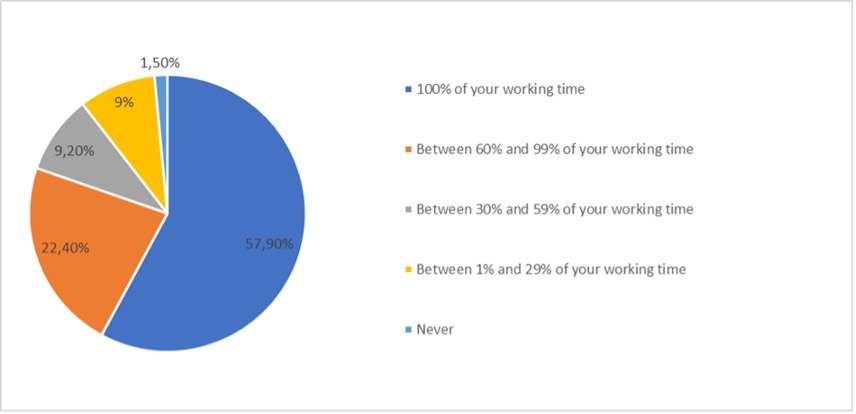
Figure 2: Employees’ opinion on the positivity of SW (Likert scale 1-5).
In general, results show that SW has qualitatively improved the work of employees and this is confirmed by 65% of employees.
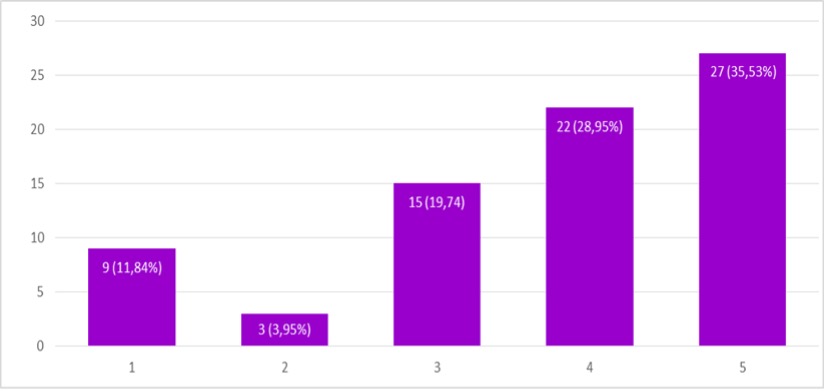
Regarding perceived improvements, 75% of employees have autonomously carried out their work unlike 25% of respondents. This confirms the literature’s findings. According to the HR Director: “the Municipality of Bari was ahead compared to other administrations because it is the only municipality in southern Italy to be part of the network of SW experimentation supported by Ministerial funds”.
Positive indicators include considerable reduction in employees’ permission of sick leave. This figure justifies the literature’s findings about SW that increases employee productivity due to a radical reduction of absenteeism and sickness.
Concerning the management of internal processes, 43% of employees believe that SW has not delivered significant changes while 38% of them believe there is an improvement. A residual percentage believes that the situation has worsened. “The real challenge, which is still open, is to understand whether the SW tool will become an ordinary mode, despite the problems in terms of the right to disconnect” (HR Director).
The Director of UPD confirms that half of the workforce (50%) should be in a smart mode every day in order to improve space management, quality of work, reduction of environmental and social costs. “I think it is useful to ask the Mayor and the Director-general to proceed with the digitisation of all documentation because this will improve things even further”.
Concerning planning of activities and services, 48% of employees believe that there has been an improvement since the introduction of SW against 40% declaring that no change occurred and 12% affirming that SW led to deterioration of planning.
Among the intangible organisational benefits, instead, it is necessary to refer to the impact of SW on management efficiency and effectiveness, measured in particular through individual and organisational performance.
Concerning the benefits linked to individual performance of a management nature (i.e. productivity of the employee), 58% of employees believe that SW improved individual worker’s productivity while 11% believe that productivity has worsened.
Regarding relations with colleagues, the majority of employees did not perceive any significant impact. Those believing that relations have worsened are a small minority (Figure 3).
In this regard, the Director of UPD stated that SW has led to improvements and, concerning the overall efficiency analysis (costs, staff productivity and space management), the pros have outweighed the cons. He said: “bringing SW to 100% of the activity for a certain period took away the minimum interaction between colleagues that is still necessary. All information goes through a single communication channel and the Certified Electronic Mail ensures transparency in communications. Then there are the time control metrics: since we have to manage everything remotely, we can track everything that happens. If we look at narrow efficiency, this has definitely improved”.
In addition, employees consider the adoption of SW a better possibility to evaluate individual performance in 38% of cases and group performance in 29% of cases. However, also in this case the majority of employees believe that SW has not significantly impacted on these aspects (54% for individual performance, 61% for organisational performance).
Concerning performance, the HR Director argued: “such an experiment has led colleagues to talk to each other much more, even if this has led public managers to monitor more constantly the activities that have been conducted in smart mode”.
Along with that, also the Director of UPD agrees on SW negative aspects, which is the lack of interaction between colleagues. Nevertheless, this is compensated by the use of platforms that have ensured dialogue and coordination of activities: “the need for coordination and relations between colleagues has been reduced. However, I tried to create internal chats on specific topics also to keep an eye on the employees. This circular solution to communication has enable SW to positively impact on horizontal line relations”.
Figure 3: Impacts resulting from the introduction of SW.
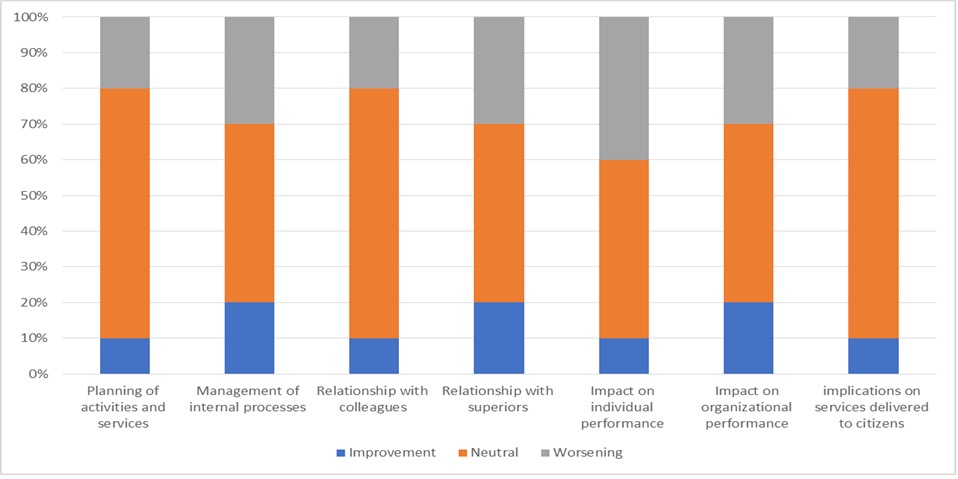
Concerning technical and technological equipment necessary to work in smart mode, 91% of employees had to use their own IT equipment while only 10% used that provided by the municipality.
Figure 4: IT equipment used.
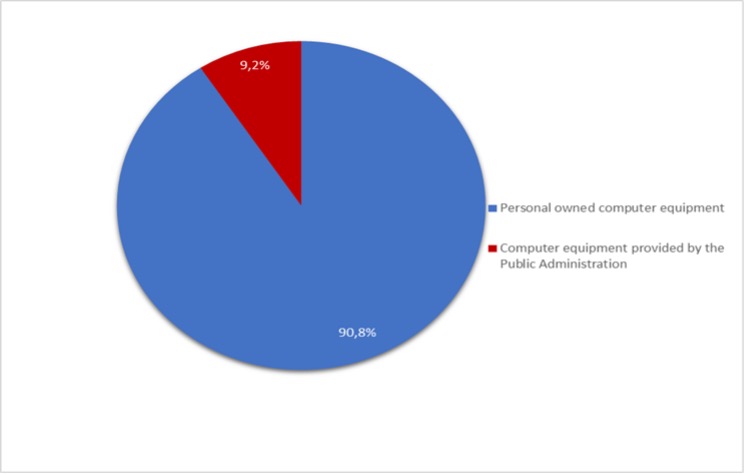
This shows that the Municipality of Bari was prepared to deal with this situation. This certainly entails a series of additional costs including maintenance, repair and updating costs but at the same time, it allows employees to fulfil contractual obligations in a correct, efficient and professional manner. This contrasts with the literature analysis because investment in hardware and software resources is necessary to ensure efficient management.
According to the HR Director, the Municipality of Bari launched a call for tender of almost €100,000 for the purchase of laptops and webcam facilities. The UPD Director affirmed that in 2016 an investment of €250,000 enabled to digitalize all office paper documents and to make a digital platform operational to deliver digital services related to management of building practices. “The office had already started to manage online procedures of building permits in 2019. The staff was already prepared to manage the work digitally. What was missing was an adequate infrastructure to manage activities that could not be conducted remotely as the necessary means are unavailable” (UPD Director).
This statement is not in line with the questionnaire’s results in terms of staff training: 92% of respondents argued that training courses about SW were never activated. This shows a time gap between start of processes change and actual implementation.
Figure 5: On-the-job training courses in SW mode.

When considering the impact of SW on service delivery, 41% did not see any significant impact on citizens, while around 30% felt a deterioration in the services provided, while 29% perceived an improvement. The Councillor of HR argued: “the Municipality was caught in an emergency situation that has been brilliantly managed by all the managers of the Divisions and criticalities are found dependent on users’ typology”.
The Director of UPD argued that the negative aspect of SW is at the front office level, hence, in the relationship between office and users. This is a problem of psychological nature, he argues: “not all activities can be carried out remotely. The most critical issue refers to access to documents. However, the goal is to find a way to bring all the physical material to digital. This entails considerable costs that will have to be planned for”.
However, it important to note that UPD is not normally exposed to general contact with citizens except from professionals: “self-certification has become the tool used by the legislator to encourage and streamline administrative procedures. Many building activities can be self-certified now and this requires a thorough knowledge by the professional of administrative acts” (UPD Director).
Concerning the impact of SW on work-life balance, 57% of employees believe that SW has positively influenced their private life while 10.5% believes the contrary due to logistic-related aspects. Another negative aspect refers to lack of direct human contact with colleagues so to consider SW an alienating form of work.
However, 28% of respondents saw both positive and negative aspects of SW that affects their private lives in equal measure. Amongst the advantages, there’s reduction of commuting time, self- organization of work activities, reduction of job-related stress, while disadvantages are: lack of human contact and physical working space, lack of free time and stress because SW requires a greater commitment to work, lack of adequate home space and less time for family.
Figure 6: Influence of SW on private life.
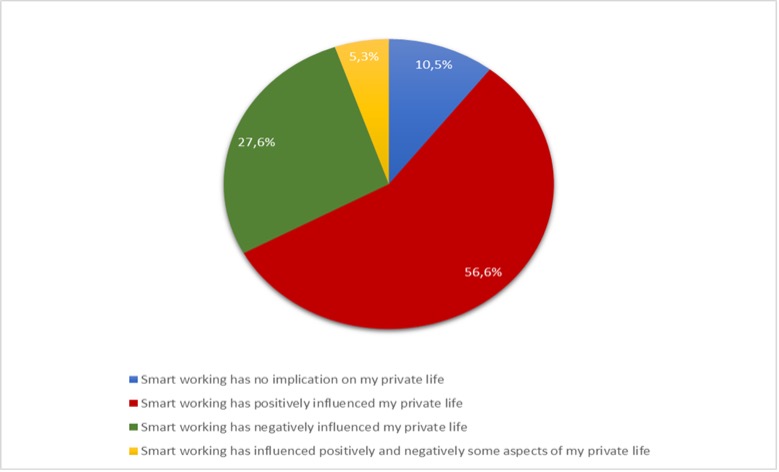
Among the benefits of SW and in order of importance, employees agree on:
- elimination of commuting time;
- better daily organisation;
- dedication to family;
- less job-related stress;
- spare time.
Among the disadvantages of SW and in order of importance, employees agree on:
- lack of adequate home space;
- lack of direct human contact;
- alienating form of work;
- lack of commuting time perceived as a break between the home and work dimension.
Regarding technical problems (e.g. malfunctioning of the system, impossibility of accessing data and information, delays in connections), these did not have a significant negative impact on the work of employees. Results show that only 37% of employees believe that technical problems negatively impacted on their way of working; 27% believe that these problems have had a sporadic impact, while around 15% believe that they have had no impact at all.
Comparing results obtained from surveys and semi-structures interviews about the perceptions of external users, a positive assessment of the service delivery is found in terms of:
- good digital interface: services are easy to find on the Web (76%),
- clarity of the information (76%),
- simple templates to fill (70%),
- availability and courtesy of the remote service staff (83%),
- adequate communication (78%),
- overall service provided online (76%).
Specifically, amongst the critical points, users pointed out several critical issues:
- files to upload were heavy;
- direct contacts during COVID-19 became practically impossible;
- need to set up a centralised service to respond to citizens and a system interface.
Among the strengths, users have emphasised on staff courtesy, employees’ efficiency, speed in information provision, completeness of files, file sent digitally have avoided queues.
6. Discussion and conclusions
The analysis of data provides stimulating insights: the introduction of SW has inevitably led to a “revolution” in working practices and lifestyles. According to RQ1, SW stands as a tool that ensures productivity even remotely although disagreement (11 %) refers to SW being less suitable for those having a low level of autonomy.
Furthermore, the results confirm the relational essence of human work, especially knowledge-intensive intellectual functions. This is the factor that has the strongest impact on SW in this case- study.
Although organizations often encourage mutual knowledge to increase workers’ intellectual productivity, SW apparently goes in the opposite direction because interaction and knowledge exchange is very difficult. There are three main negative aspects of SW: the first refers to the relational nature of human work; the second attains to the physical space where work is carried out: not all employees have found that working remotely is comfortable. This research demonstrates that working without a constant supervision was not negatively perceived probably because the manager recognises full autonomy of employees because they’re highly qualified, thus, fully responsible.
The third one refers to SW as a form of alienating work due to lack of direct human contact with colleagues, lack of adequate home space, and lack of commuting that separates domestic dimension from work.
Concerning RQ2, results show that the UPD has been a successful case during COVID-19 due to existing favourable managerial and organisational conditions. Employees’ activities were carried out independently, workers’ performance and processes were constantly monitored thanks to a transformative leader.
This case-study, nevertheless, needs to be extended to other municipal offices in order to confirm the value of the SW. This study contributes to fill gaps in the literature where the phenomenon of SW is analysed specifically to the health sector and telemedicine.
This work shows limitations: firstly, reference to the lock-down period only is misleading because it does not allow a complete assessment of the actual impact of SW. Secondly, the organisational and management peculiarities of UPD may have biased results.
The study, however, can be developed and implemented according to temporal and longitudinal perspectives. It will be important to analyse the impacts of SW in a medium-term horizon and to broaden the issue by carrying investigations on other public administrations.
References
Bednar, P.M., Welch, C. (2020). Socio-Technical Perspectives on Smart Working: Creating Meaningful and Sustainable Systems. Information Systems Frontiers, 22, 281–298. https://doi.org/10.1007/s10796-019-09921-1
Bolisani, E., Scarso, E., Ipsen, C., Kirchner, K., Hansen, J. P. (2020). Working from home during COVID-19 pandemic: lessons learned and issues. Management & Marketing. Challenges for the Knowledge Society, 15(s1), 458-476. https://doi.org/10.2478/mmcks-2020-0027
Brannen, J. (2005). Mixing Methods: The Entry of Qualitative and Quantitative Approaches into the Research Process, International Journal of Social Research Methodology, 8(3), 173-184. https://doi.org/10.1080/13645570500154642
Bentley, T. (2014). How can organisations realize the positive benefits of ‘anywhere working’? Human Resource Magazine, 8–11
Bonanni, R., Danza M. (2020). Smart Working Tra Crisi e Innovazione. Bertoni.
Brynjolfsson, E., Horton, J. J., Ozimek, A., Rock, D., Sharma, G., TuYe, H. Y. (2020). COVID-19 and remote work: An early look at US data. Cambridge: National Bureau of Economic Research, report N° 27344
Bruni, E., Parolin, L. (2014). Dalla Produzione Automatizzata Agli Ambienti Tecnologicamente Densi: La Dimensione Sociomateriale Dell’agire Organizzativo. Studi Organizzativi, 1, 7–26.
Cavalluzzo, K.S., Ittner, C.D (2004). Implementing Performance Measurement Innovations: Evidence from Government. Accounting, Organizations and Society, 29 (3/4), 243–267. 10.1016/S0361-3682(03)00013-8.
Clapperton, G., Vanhoutte, P. (2014). Il Manifesto dello Smart Working. Quando dove e come lavorare meglio, Sunmakers.
Coughlan, M. (2009). Interviewing in qualitative research: the one-to-one interview. International Journal of Therapy and Rehabilitation, 16(6), 309-314.
De Antonio J.H., Kang H.S., Cockrell H.C. (2019). Utilization of a handheld telemedicine device in postoperative pediatric surgical care. J Pediatr Surg, 54(5), 1005–8. DOI: 10.1016/j.jpedsurg.2019.01.032
De Lancer Julnes, P., Holzer, M. (2014). Performance measurement: Building theory, improving practice. Routledge.
Eisenhardt, K. M. (1989). Building Theories from Case Study Research. The Academy of Management Review, 14(4), 532-550. https://doi.org/10.2307/258557.
Eltrudis, D., Monfardini P. (2019). La Performance Organizzativa in Italia: Un’analisi Critica. Azienda Pubblica 32, 2, 157–170.
Fogarty, H., Scott, P., & Williams, S. (2011). The half-empty office: dilemmas in managing locational flexibility. New technology, work and employment, 26(3), 183–195. https://doi.org/10.1111/j.1468-005X.2011.00268.x.
Fragouli, E., & Ilia, I. (2019). Working smart and not hard: key to maximize Employee efficiency? . International Journal of Information, Business and Management, 11(2), 74-111. https://ijibm.elitehall.com/index4.htm.
Gastaldi, L., Corso, M., Raguseo, E., Neirotti, P., Paolucci, E., Martini, A. (2014). Smart Working: Rethinking Work Practices to Leverage Employees’ Innovation Potential. In 15th CINet Conference ‘Operating Innovation – Innovating Operations, 337–347.
Gottlieb, C., Grobovšek, J., & Poschke, M. (2020). Working from home across countries. COVID Economics, 1(8), 71-91. https://EconPapers.repec.org/RePEc:mtl:montec:07-2020.
Hamel, G., Breen, B.(2007). The Future of Management. Human Resource Management International Digest, 16(6). DOI:10.1108/hrmid.2008.04416fae.001
Hassan, S. (2016).Smart work and efficiency at the work place. The American University in Cairo – AUC, Knowledge Fountain. https://fount.aucegypt.edu/etds/289.
Hinna, A., Mameli, S., Mangia, G., Tomo, A. (2018). Cambiamento e Complessità Nella Pubblica Amministrazione. Ruoli, Risorse e Trasparenza. Milano: Egea.
Kahn, W.A. (1990). Psychological Conditions of Personal Engagement and Disengagement at Work. Academy of Management Journal, 33(4), 692–724. https://doi.org/10.5465/256287
Kang, Y. S., Kwon, S. D. (2016). A Study on the Influencing Factors of Smart-Work Performance. Journal of Information Technology Applications and Management, 23(1), 61-77. https://doi.org/10.21219/jitam.2016.23.1.061.
Kim, Y. Oh, S. (2015). What Makes Smart Work Successful? Overcoming the Constraints of Time. Geography, 1038-1047.
Iannotta M., Meret C., Marchetti, G. (2020). Defining leadership in smart working contexts: a concept synthesis. Frontiers in Psychology. 11, 556933. https://doi.org/10.3389/fpsyg.2020.556933
Lambert S.D., Loiselle C.G. (2008). Combining individual interviews and focus groups to enhance data richness. J Adv Nurs, 62(2), 228–37. DOI: 10.1111/j.1365-2648.2007.04559.x.
Langè, V. & Gastaldi, L. (2020). Coping Italian Emergency COVID-19 through Smart Working: From Necessity to Opportunity. Journal of Mediterranean Knowledge-JMK, 5(1), 163-172. DOI: 10.26409/2020JMK5.1.10.
Liao, C. (2017). Leadership in Virtual Teams: A Multilevel Perspective. Human Resource Management Review, 27(4), 648–659. https://doi.org/10.1016/j.hrmr.2016.12.010.
Martone, A., Galanto P, Montonati P., Ramponi M., Righetti A., Sciaroni F. (2018). Smart Working, Job Crafting, Virtual Team, Empowerment. Wolters & Kluwer.
May, D.R., Gilson, R.L. Harter, L.M. (2004). The Psychological Conditions of Meaningfulness, Safety and Availability and the Engagement of the Human Spirit at Work. Journal of Occupational and Organizational Psychology, 77(1), 11–37. https://doi.org/10.1348/096317904322915892.
Mihhailova, G., K. Õun, Türk K. (2011). Virtual Work Usage and Challenges in Different Service Sector Branches. Baltic Journal of Management, 6(3), 342–356. DOI:10.1108/17465261111167984.
Muganda, N., Pillay K. (2013). Forms of Power, Politics and Leadership in Asynchronous Virtual Project Environment: An Exploratory Analysis in South Africa. International Journal of Managing Projects in Business, 6(3), 457–484. DOI:10.1108/IJMPB-11-2011-0075.
Patton, M. Q. (2002). Qualitative research and evaluation methods, 3rd edition. Thousand Oaks, CA: Sage.
Patton, M. Q. (2015). Qualitative research & evaluation methods: Integrating theory and practice, 4th edition, Thousand Oaks, CA: Sage.
Renn, R.W., Vandenberg, R.G. (1995). The Critical Psychological States: An Underrepresented Component in Job Characteristics Model Research. Journal of Management, 21(2), 279–303. DOI:10.1177/014920639502100206.
Rodriguez Socarrás, M., Loeb, S., Teoh, J. Y. C., Ribal, M. J., Bloemberg, J., Catto, J., N’Dow, J., Van Poppel, H., Gómez Rivas, J. (2020). Telemedicine and Smart Working: Recommendations of the European Association of Urology. European Urology, 78(6), 812-819. 10.1016/j.eururo.2020.06.031.
Sarti, D., Torre, T. (2017). Is Smart Working a Win-Win Solution? First Evidence from the Field. In Addabbo, T., Ales E., Curzy Y., Senatori I., Well-being at and through. WorkPublisher: Giappichelli.
Scapens, R. W. (2006). Understanding management accounting practices: A personal journey. British Accounting Review, 38(1), 1-30. https://doi.org/10.1016/j.bar.2005.10.002
Schepers, J.J.L., de Jong, A., Ruyter J.C., Wetzels, M.G.M. (2011). Fields of Gold : Perceived Efficacy in Virtual Teams of Field Service Employees. Innovation Technology Entrepreneurship & Marketing, 14(3), 372–389. 10.1177/1094670511412354.
Shamir, B. (1991). Meaning, Self and Motivation in Organizations. Organization Studies, 12(3), 405–424. https://doi.org/10.1177/017084069101200304.
Sparrow, P., Balain, S. (2010). Engaging HR Strategists: Do the Logics Match the Realities? In Albrecht, S.L. (Ed.). Handbook of Employee Engagement, 283–296. Cheltenham: Edward Elgar.
Talbot, C. (2010). Theories of Performance: Organizational and Service Improvement in the Public Domain. Oxford: Oxford University Press.
Verhoef, P. C., Broekhuizen, T., Bart, Y., Bhattacharya, A., Dong, J. Q., Fabian, N., & Haenlein, M. (2021). Digital Transformation: A Multidisciplinary Reflection and Research Agenda. Journal of Business Research, 122, 889-901. https://doi.org/10.1016/j.jbusres.2019.09.022
Visentini, A., Cazzarolli, S. (2019). Smart Working: Mai Più Senza. Guida Pratica per Vincere La Sfida Di Un Nuovo Modo Di Lavorare. Milano: FrancoAngeli.
Yin, R.K. (2015). Case Study Research : Design and Methods. 5th edition. London: Sage Publication.


